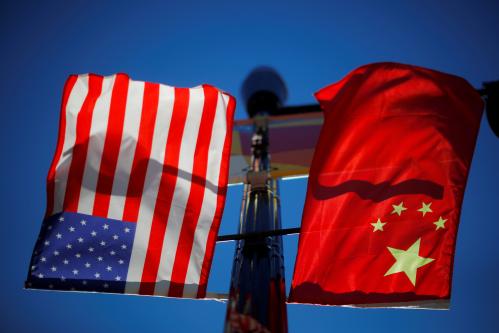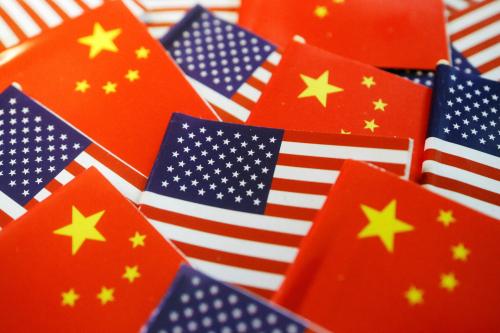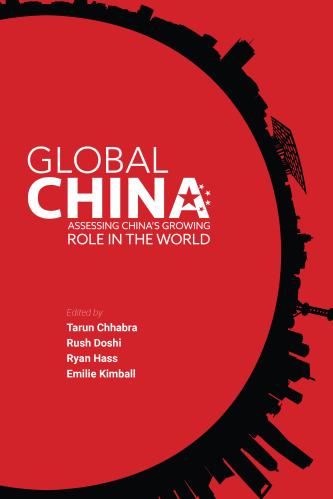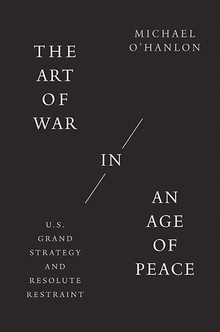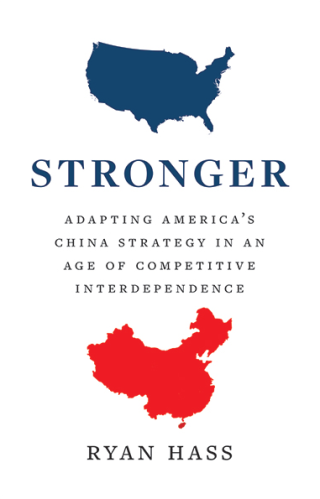In this written debate, the authors address the title question with essay-length opening statements. The statements are followed by an interactive series of exchanges between authors on each other’s arguments. The goal of this product is not to reach any conclusion on the question, but to offer a rigorous examination of the choices and trade-offs that confront the United States in its competition with China.
The United States is entering a consequential period in its relations with China and how the contours of this bilateral relationship are defined will dictate both countries’ foreign policy agendas for decades to come. Some have characterized the intensifying competition between the United States and China as “a new Cold War.” Is this an accurate framing for the relationship? What lessons from the U.S.-Soviet Cold War are — or are not — applicable to U.S.-China competition today? What does “success” entail if the United States seeks to prevail in strategic competition with China? And what kind of coexistence is possible between the two great powers?
To answer these questions and articulate the policy choices facing the United States, Patricia M. Kim, Ryan Hass, and Emilie Kimball, co-leads of the Brookings Foreign Policy project: “Global China: Assessing China’s Growing Role in the World,” convened a group of leading experts — Jessica Chen Weiss and Eun A Jo, Patricia Kim, Joseph S. Nye Jr. and Matthew Turpin — to engage in a written debate to examine if the United States and China are destined for Cold War-like rivalry. Their opening statements and two rounds of vigorous exchange follow below:
Vigorous, but not existential, competition
Competition is a defining feature of human existence and is omnipresent at all levels of social interaction. The United States and China, as the world’s first and second-largest economies, top military spenders, leading filers of patents, and elite contenders for Olympic medals, are bound to be in competition for the foreseeable future. But whether this competition can remain rational or drift in a debilitating direction to the detriment of the United States and China’s respective interests, and the interests of the world, will depend on the choices and political will of both sides.
The last time Washington found itself in an intense peer rivalry was during the Cold War, when the United States and the Soviet Union were locked in a fierce competition for geopolitical dominance. Washington’s guiding strategy at the time was a policy of containment to check Soviet expansionism and the spread of communism. As George Kennan argued in his seminal Foreign Affairs article, containment was necessary because the Soviets viewed the “capitalist world” as a direct threat to its socialist system and that Moscow would never see “any sincere assumption of a community of aims” between itself and non-socialist powers. Over the next four decades, Moscow would go on to fund left-wing revolutionary movements across the globe. The United States and the Soviet Union found themselves facing off in proxy battles in far-flung regions — too many of which were “hot” conflicts that cumulatively left millions dead and spawned historical legacies and political dilemmas that continue to destabilize regions today.
There are many reasons why China cannot simply be slotted into the role of the Soviet Union, including the oft-cited fact that the U.S. and Chinese economies are too deeply intertwined following a period of rapid globalization in the post-Cold War era. In addition to this important reality, a fundamental difference between today’s China and the Soviet Union is that Beijing does not seek to overthrow democratic regimes or force its political model on others (with the critical exception of Taiwan, which it claims as its territory). At home, the Chinese Communist Party (CCP) runs an increasingly repressive authoritarian system and justifies its model as “fit” for China’s “national conditions.” It seeks respect and admiration for its own system, rails against outside criticism, and seeks to shape the global order to favor its interests. Yet it does not see capitalism or the existence of other democracies as antithetical to its own existence. In short, China does not pose an existential threat to the U.S. homeland or way of life. In fact, China’s comprehensive ties with the United States and other democracies since the launch of its “reform and opening” policy have been foundational for its rise and the vast improvement of its people’s quality of life over the last three decades.
To be sure, Beijing has never embraced fully fair and reciprocal exchanges in efforts to advantage its own industries; it has restricted the flow of information into and increasingly out of its territory to prevent challenges to the CCP’s legitimacy at home. It has weaponized its economic heft in attempts to impose its will on counterparts. But even as Chinese leaders have called for greater self-sufficiency sensing geopolitical headwinds, they have also pressed their counterparts in the United States, Europe, Asia, and elsewhere not to unravel the threads of interdependence. Furthermore, they have expressed interest in stabilizing relations because simply put, China’s growth and prosperity hangs on its continued engagement with the outside world.
Rather than a sledgehammer of full-blown containment, a more surgical, multidimensional approach is necessary to deal with the complex challenges and opportunities China brings to the table.
As the United States and its partners flesh out their strategies toward China at this critical juncture, assessing precisely what kind of threats Beijing does and does not pose and defining concrete parameters of success will be critical for long-term success. Rather than a sledgehammer of full-blown containment, a more surgical, multidimensional approach is necessary to deal with the complex challenges and opportunities China brings to the table.
For instance, China is not intent on displacing the United States as the world’s dominant military power and is unlikely to present a global military challenge in the near future. But China does seek military superiority in its immediate periphery to advance its claims vis-à-vis Taiwan, in the South and East China Seas, and other contested territories along its borders. This poses a distinct and critical threat to the United States’ alliance commitments and its ability to operate freely in the Indo-Pacific region and must be counterbalanced in conjunction with allies and partners. But deterrence should also be crafted with the clear understanding that military means are not Beijing’s sole or necessarily preferred means of advancing its core interests. Strengthening economic, diplomatic, and security ties with partners around China (and with China as well) will be critical for preserving stability and maintaining an environment favorable to U.S. interests in the decades to come.
On the economic front, there is a rush to protect the United States’ technological advantages through unprecedented export restrictions and to reduce U.S. vulnerabilities by cutting China out of key supply chains. Before moving too sweepingly in such a direction, however, a broader examination is warranted not just of potential short-term wins but also the long-term consequences of such actions. For instance, what kind of precedents and norms are U.S. policies setting for the global economic order? And how might they come back to bite us in the future? Economic and technological linkages create mutual vulnerabilities and strengthen the incentives for all parties to maintain stable relations. How will reduced U.S.-China interdependence impact Washington’s ability to deter Beijing from resorting to coercion or to solicit its cooperation on some pressing challenge? If or when China matches or surpasses the United States in certain technologies fully independent of the West, what leverage will Washington and its allies have to negotiate safeguards and restraints to ensure these new technologies are not employed in unethical or destabilizing ways? Failing to exhaustively think through the tradeoffs and potential knock-on effects of today’s de-risking policies could put the United States on its back foot tomorrow.
In addition, Beijing brings a much more subtle diplomatic and ideological challenge to the table than that of the Soviet Union or Mao Zedong’s revolutionary China. Its mantra that it’s willing to do business with any state regardless of its regime type, champion development, and seek a “multipolar” global order in which non-Western states have a greater say are messages that sell quite well in the developing world. Competing against such a campaign will require building soft power, delivering resources, and addressing genuine grievances that exist in the Global South, rather than loudly warning others against working with Beijing and indiscriminately countering its presence everywhere.
Finally, not all Chinese endeavors, whether economic initiatives or diplomatic feats, should be written off as detrimental to U.S. interests. Many global challenges, like the war in Ukraine, nuclear proliferation, climate change, and debt relief, call for China to be a part of the solution. Finding ways to cooperate with China in this competitive era will require rising above one-dimensional thinking that casts any “win” for China as a “loss” for the United States. Of course, Chinese leaders and citizens will need to do the same and some may raise doubts about Beijing’s intentions and willingness to cooperate. But resigning to a new cold war without reaching for a more constructive coexistence would be highly irresponsible and in neither country’s interests.
The CCP views us as an existential threat … now what?
For the last few years, a new geopolitical condition has emerged. The United States and the People’s Republic of China coexist in a multipolar world in which each side is deeply suspicious of and hostile to the worldview of the other. Simultaneously, both countries recognize that they cannot overpower their rival, which compels both to avoid direct military conflict, while pushing their rivalry into other domains.
This geopolitical condition is called a cold war.
To start, it is important to differentiate between the term “cold war” and the proper noun “Cold War,” an event that took place between the United States and the Soviet Union from 1947 to 1991. The historical event involved specific circumstances and actors, but the condition defined by the term (a state of political hostility between countries that unfolds across all domains short of open, direct warfare) aptly applies to today’s Sino-American situation, just as it did a generation ago with the Soviets.
Therefore, the question that some still ask — are the United States and the PRC “destined” for a new cold war — is a category error. The cold war already exists. The questions we should be asking are: how do we want it to unfold and how long will it last?
One of the unique attributes of cold wars is that their beginning can only be perceived in retrospect. Belligerents don’t issue formal declarations; a cold war starts incrementally as the weight of actions by both sides builds until we reach what George Orwell called “a peace that is no peace.” If your rival is reluctant to acknowledge a cold war exists, it can be advantageous to paint them as harboring a “Cold War mentality” to complicate their political decisionmaking, even as you wage one yourself.
Observing that we are in a cold war is not something to be celebrated, it is a grim reality. Cold wars are costly and dangerous, but they are the least bad option. It is even more costly and dangerous to pretend that one isn’t taking place, to allow ambiguity and miscalculation to fester. As a society built on the consent of the governed, Americans must face this challenge and achieve broad consensus on our goals. Pretending that this challenge will go away if we just don’t talk about it leads to instability and miscalculation. While it may seem comforting to some, it is the opposite of a responsible policy.
To be clear, this is not the outcome Americans wanted. It would have been objectively better had China gone through a process of political liberalization to match the economic development the Chinese people experienced since the death of Mao. Our strategy had been to assist with economic development and strengthen people-to-people relations, in short, to engage with China, so that political liberalization could take place and the PRC could become more soluble within a liberal international order. This had been a strategy the United States employed with numerous authoritarian regimes. Some resulted in spectacular successes and others in failure.
It is important for Americans to understand that the Chinese Communist Party perceived our strategy of engagement as an existential threat to the party.
To appreciate this new geopolitical condition, it is important for Americans to understand that the Chinese Communist Party perceived our strategy of engagement as an existential threat to the party. This was not our aim; we believed that our actions and policies reassured China of our peaceful and cooperative intentions. No doubt, many Chinese citizens understood our policies as being in good faith and focused on mutual prosperity. But that is not how the leadership of the Chinese Communist Party interpreted our strategy. Where we perceived reassurance, the party saw infiltration and hypocrisy. From their perspective, engagement weakened the party’s monopoly on power and sought to constrain it within a set of rules and norms that favored transparency, rule of law, separate spheres for civil society, and limited government — concepts that pose mortal threats to a Leninist party system. As Stephen Kotkin and Orville Schell recently argued in a Foreign Affairs podcast, there is “no political reform equilibrium” for Leninist parties. As cracks formed near the end of Hu Jintao’s rule and color revolutions unfolded in other countries, the party recognized the danger and set out on a path to protect itself. Leveraging its new-found comprehensive national power, the party initiated what would become a cold war with the United States, as it simultaneously sought to buy time for itself to strengthen its position domestically and internationally.
Acknowledging that the party perceives the United States as an existential threat is critical for understanding the changes over the last decade. This threat perception appears in Xi Jinping’s inaugural address to the Central Committee on January 5, 2013. He demanded that the party learn how “historical nihilism” destroyed the Communist Party of the Soviet Union. He calls on the party to prepare for “a long period of cooperation and conflict between [the PRC and developed Western nations] in the economic, technological, and military spheres.” He commanded the party to move itself toward the dominant position in the international system to prepare for the time when “capitalism is bound to die out and socialism is bound to win.” And he stresses the critical importance of ideological work in determining the success or failure of the party. Xi recognizes that a cold war between the PRC and the United States is emerging and in his first months in power, he began to outline the party’s strategy to win.
Much ink will spill debating which side is most responsible for this new cold war or if it could have been averted. (Spoiler alert: both sides bear responsibility.) But that effort to determine the origins of the Sino-American cold war does not require consensus before U.S. policymakers and the American people address more pressing questions: how should we wage a cold war that we did not want, but find ourselves in? And how should we define success?
For a democracy like ours, the hard work of answering those questions starts with admitting that we face an enormous problem: a peer superpower views us as an existential threat. Only then can we address those questions and develop a strategy that will require compromise, sacrifice, responsible leadership, and significant time.
A new cold war with China?
The great power competition between the United States and China is a defining feature of the first half of the 21st century, but there is little agreement on how it should be characterized. If “Cold War” means intense prolonged competition, then we are in one, but if the term is used as a historical metaphor for the past, then we are not (yet), and should avoid it.
Analogies to the historical Cold War can mislead us about the real challenges we face from China. The United States and the Soviet Union had a high level of global military interdependence, but virtually no economic or social interdependence. Moreover, ecological interdependence such as climate change was not yet an issue. The China challenge today is quite different.
We cannot decouple our economy completely from China without enormous economic costs to us, our allies, and third countries. The United States does over half a trillion dollars in trade annually with China, and China has learned to harness the creativity of markets to authoritarian Communist Party control in ways the Soviets never mastered. The United States and its allies aren’t threatened by the export of communism, but by a system of economic and political interdependence that both the United States and China can manipulate. Partial decoupling or “de-risking” on security issues is necessary, but total economic decoupling would be very costly, and few allies would follow suit. More countries count China than the United States as their leading trade partner.
Meeting the China challenge will require a more complex strategy that leverages the alliances and rules-based system we created.
Moreover, the ecological aspects of interdependence such as climate change and pandemics obey the laws of physics and biology which make decoupling impossible. No country can solve these transnational problems alone. Global interdependence requires using power with others as well as over others. For better and worse, we are locked in a “cooperative rivalry” with China in which we need a strategy that can accomplish two contradictory things at the same time. This is not like Cold War containment. Meeting the China challenge will require a more complex strategy that leverages the alliances and rules-based system we created. Our allies and partners like India are assets that China lacks. While the center of economic gravity has shifted from Europe to Asia over the past century, Asia includes India, which is a Chinese rival, not an ally. Moreover, the combined wealth of the Western democratic allies will far exceed that of China (plus Russia) well into this century.
If we define strategic success as transforming China in a way similar to the collapse of the Soviet regime at the end of the Cold War, we are likely to fail. Although the Communist Party fears Western liberalization, China is too big for us to invade or coerce domestic change, and the reciprocal is true. In that sense, neither China nor the United States poses an existential threat to each other unless we blunder into a major war. The most apt historical metaphor is not Europe in 1945 but Europe in 1914. We should expect low intensity and economic conflict, but our strategic objectives should be to avoid escalation — U.S. Secretary of State Antony Blinken has used the slogan of “peaceful coexistence” — and to preserve the alliances and institutions that will continue our role as the leading (though not hegemonic) country in the future.
Are these strategic objectives feasible given the growth of Chinese power? Yes, because we have been dealt a strong hand if we play it well. The United States has major geopolitical advantages, and China is unlikely to displace us as a leading power. Geographically, we are bordered by two oceans and friendly neighbors, while China has territorial disputes with India, Indonesia, Japan, Malaysia, the Philippines, and Vietnam. A second advantage is energy: the shale oil and gas revolution has transformed the United States from an importer to an exporter. China, on the other hand, is highly dependent on energy imports passing through the Persian Gulf and the Indian Ocean, where the United States has naval supremacy. The United States also has a demographic advantage with a workforce that is likely to grow over the next decade, while China’s will shrink. China’s working-age population peaked in 2015, and India has passed China as the world’s most populous nation. And while China excels in some subfields, America remains at the forefront in the key technologies of biotechnology, nanotechnology, and information technology. American research universities dominate higher education while no Chinese universities rank in the top twenty. China has impressive strengths, but also serious weaknesses and problems. The answer to its demographic decline is to increase productivity but total factor productivity has been dropping, and tight party control of private entrepreneurial talent may weaken the geese that lay golden eggs.
While the United States holds high cards, a misguided strategy could lead us to discard our aces of alliances and international institutions or severely restrict immigration. Former Singaporean Prime Minister Lee Kuan Yew said he did not think China would surpass the United States because of America’s ability to draw on the talents of the entire world and to recombine them in diversity and creativity. Given its ethnic nationalism and party state, this kind of openness is not possible for China.
Our strategy toward China should use deterrence to avoid either a hot or cold war, cooperate when possible, and marshal our assets to compete successfully. Our strategic objective should be to shape China’s external behavior by strengthening our alliances and international institutions. The key to the first island chain off China’s shore is Japan, a close American ally where we station troops. At the same time, we should bolster our economy and technological advantages at home. A more active Asian trade policy would be wise, and we should offer assistance to poor countries being wooed by China. We must maintain our domestic openness and democratic values that polls show have given us much greater soft power than China. Strengthening our military power of deterrence is welcomed by the many countries that want to maintain friendly relations with China but do not want to be dominated by it. If we avoid demonization and misleading historical analogies, we can manage a strategy that holds more promise for us than a new cold war.
A principled approach to dealing with China
The Cold War analogy is tempting. It provides a powerful plea to Americans to band together to fight a common threat and evokes memories of American victory at the end of a protracted contest against an “evil empire.”
But the analogy distorts more than it clarifies, and it increases the danger of counterproductive rhetoric and policy. It neglects the degree of economic and technological interdependence that makes Chinese participation necessary to tackling shared challenges such as climate change and the renewable energy transition. It ignores the economic reality that China is the largest trading partner of more than 120 countries and that few — if any — countries would be willing to fully align with the United States against China.
The risk of casting China as an existential ideological adversary — against considerable evidence — is that it alienates the United States from the rest of the world even as it fuels increasingly reactive, zero-sum efforts to thwart China at any cost, including the United States’ own values and international leadership.
The two countries are not destined for a Cold War-like rivalry, but fatalistic thinking makes a cold — or even a hot — war more likely. Even under Xi Jinping — the most activist among post-Mao leaders — the Chinese Communist Party is more focused on bolstering regime security at home than exporting revolution abroad. The CCP is more concerned with whether countries in the developing world defer to “One China” than whether they are governed by democratic, capitalist, or Marxist-Leninist ideas.
Xi’s self-serving emphasis on ideology is also unlikely to consolidate a Cold War-like bloc. A shared communist heritage has not endeared China to its Vietnamese neighbors. And Beijing’s coercive tactics against foreign businesses and trading partners have fueled concern and backlash. Despite efforts to build soft power abroad, public opinion toward China has deteriorated sharply in many parts of the world. Developing countries that accept Beijing’s financial support do so not because they embrace “socialism with Chinese characteristics,” but because Chinese lenders often provide local leaders with a more expedient and accommodating source of development finance.
The truth is few other countries want to rally around ideological banners today. They seek autonomy, freedom from coercion, and opportunities to develop and prosper. Many in Africa and Latin America continue to see China’s growing economy as a boon for their country — ranging from 83% of the public in Nigeria to 54% in Argentina. Even as suspicions about Chinese investments have grown in the region, “Asian countries do not want to be forced to choose between the two,” as Singaporean Prime Minister Lee Hsien Loong noted in 2020.
Projecting a domestic struggle between the forces of democracy and autocracy onto global politics will not resonate among would-be partners.
Projecting a domestic struggle between the forces of democracy and autocracy onto global politics will not resonate among would-be partners. Following a catastrophic pandemic response that resulted in over a million deaths (and counting), combined with a deadly insurrection on Capitol Hill in 2021, the United States’ appeal and credibility in the world have taken a significant hit. Even U.S. allies do not always see the United States as a good model for democracy or a very reliable partner. This has improved under the Biden administration but anxieties about the United States’ staying power, in light of the impending 2024 U.S. presidential elections, still loom large.
Instead, the best course of action for the United States is to cultivate a peaceful and constructive — if also competitive — coexistence with China. Rather than competing for competition’s sake, the United States must aim at a principled framework that establishes bounds around competitive actions, creating space for attention and resources to areas where U.S. and Chinese interests overlap — from developing and manufacturing renewable technology to supporting an eventual peace settlement in Ukraine.
At a minimum, the two countries must bolster the principles of sovereignty and nonaggression set forth in the U.N. Charter and rekindle the spirit of pragmatism that recognizes shared interests in a world of diverse systems. In this light, U.S. strategy must subordinate efforts to outcompete China to a positive vision of what the United States — and China — can offer the world.
For all their rhetoric about “the East is rising and the West is declining,” Chinese leaders appear to understand that China will not surpass the United States anytime soon in GDP, let alone other more meaningful metrics of national strength. This creates a window of opportunity to stabilize the relationship within a reformed international order that fosters constructive coexistence.
So far, the most concrete statement of the U.S. economic approach to China has been “de-risking, not decoupling.” As Washington clarifies what this means in application, it must also take stock of the benefits of continued technological integration and commercial engagement with China. Where legitimate and beneficial to American and global interests, the United States must work to preserve and expand ties.
To rally as broad and inclusive a coalition as possible, the United States must identify objectives beyond maintaining as large a lead as possible over China and align them with appropriate means that deter rather than provoke. This means recognizing that some degree of economic interdependence remains an important source of restraint on Chinese bellicosity. It also requires maintaining regular and sustained high-level diplomacy to build new rules of engagement, including mechanisms to identify areas of possible compromise and agreements on areas of shared interest.
The liberal international order was always less liberal than its proponents suggested. Even at the height of the unipolar moment, the United States struggled to impose democratic values and systems on the world, with grave unintended consequences. In today’s more multipolar world, the United States must set more realistic goals and prioritize — first and foremost — getting its own liberal house in order.
JOSEPH S. NYE JR.
I am struck by the positive overlap in the essays. None expect what Turpin calls Cold War “as a historical noun,” and all agree as Kim says, that a prolonged and intense competition already exists. But as she goes on to say that “competition is a defining feature of human existence,” the important question is what type of competition and where it lies on a spectrum from rational to drifting into catastrophe. Or in Turpin’s words, we already face a “grim reality,” but how grim remains an open question. He refers to “all domains” in a multipolar world.
But how multipolar is the world? Elsewhere I have argued that this terminology oversimplifies a reality that is more like a three-dimensional chess game. On the top board of military competition, China’s investment in nuclear weapons is gradually making the world more multipolar, but in terms of a country’s ability to project and support military power on a global basis, the world remains largely unipolar. On the second board of economics, the world is multipolar with the United States, China, Europe, and Japan as great powers, and this has been true for more than a decade. On the third board of transnational relations which cross national borders outside of governmental control (such as climate change and pandemics), the traditional language of state polarity makes no sense. The three domains are different and represent different mixes of potential conflict and cooperation. A wise strategy should not blur these distinctions.
As Kim points out, in the overall political competition, this degree of pluralism makes a difference. Both the Soviet ruling elites and the Chinese Communist Party have seen American liberalism as a threat to their existence, but the Soviets tried to export their ideology and challenge the American global military presence. China under Xi (as contrasted with Mao) does not. In the bipolar competition of the real Cold War, the Soviet challenge turned many peripheral conflicts into proxy wars between the two superpowers. Under multipolarity and plural centers of power, there is less pressure to turn marginal interests into zero-sum conflicts than under bipolarity. Thus, one could expect this prolonged intense competition to be manageable.
But as I used to tell analysts when I chaired the National Intelligence Council, every estimate should be accompanied by a little box that explains one’s assumptions and illustrates what could make the analysis all wrong. I can think of at least three things that might do so for my estimate above. One is an unintended crisis over Taiwan that gets out of hand. For example, if China tries a blockade, and an American ship is sunk or plane shot down, invocation of sanctions and the Trading with the Enemy Act could quickly turn the managed competition into something resembling the historical Cold War.
A second scenario might be a shift In Chinese domestic politics arising out of nationalism replacing economics as the basis for legitimizing party rule as the economy continues to slow down. Under such circumstances, the CCP might become more assertive in exporting its ideology and challenging the U.S. global military position. And a third scenario might arise out of changes in American domestic politics. Weiss and Jo describe current efforts to “de-risk” rather than “decouple” economic interdependence. As National Security Advisor Jake Sullivan has put it, our strategy has been to build a high fence around a small yard. But if there is an economic recession and/or the isolationist wing of the Republican Party makes common cause with protectionist Democrats, rising protectionism and bipartisan demonization of China may make the small yard expand greatly. In those circumstances, the competition is more likely to drift away from Kim’s rational end of the spectrum. There is no one future for us to discern, but thinking about alternative scenarios can improve our ability to design a robust strategy along the lines I suggest above.
MATTHEW TURPIN
If the underlying causes of this new cold war were American insecurities, then I would be confident that we could achieve constructive or peaceful coexistence.
Unfortunately, that isn’t the cause of this new cold war.
For Xi and his cadres, bolstering regime security at home requires remaking the international system. The system was purpose-built to advantage liberal governance models and undermine authoritarian regimes. The existence of liberal governance models (even imperfect ones like our own) poses an existential threat to the party. As the party’s power grows, so too does its threat horizon. It can never achieve the regime security that it craves, it is a Sisyphean task.
This is a fatal contradiction for the party: it cannot hermetically seal itself from the outside world, and the outside world spawns the ideas that threaten the party’s rule. No amount of reassurance can resolve their dilemma.
The success of liberal governance provides the Chinese people with concrete examples of how they “could” govern themselves without the party. The whole “One China” issue is a microcosm of this dynamic: Taiwan, an independently governed Chinese polity, refutes the entire narrative of the Chinese Communist Party. For if Chinese living in Taiwan can govern themselves successfully and achieve impressive levels of prosperity, an obvious question arises: Why must other Chinese accept the party’s monopoly hold on power?
Some see the “climate crisis” and the energy transition as an opportunity for constructive coexistence, but I am deeply skeptical. Earlier energy transitions (wind-to-coal, coal-to-oil) have only accentuated geopolitical rivalry. Whether a country’s leaders recognize it or not, the energy transition is already subject to significant security pressures.
In examining the term “cold war,” I think we are talking past one another.
I define “cold war” as a condition. A term synonymous with a long-term, acute geopolitical rivalry across all domains short of direct military conflict. The objective of a “cold war” is to outlast your rival and win without fighting. States that find themselves in a cold war must develop a strategy that fits the circumstances.
I think my colleagues define “cold war” as a strategy to address a geopolitical condition. Their rejection of “cold war” reflects a dismissal of what they perceive as a carbon copy of the first Cold War grafted onto different circumstances.
I think it is critical not to confuse strategies with conditions.
JESSICA CHEN WEISS AND EUN A JO
Assuming that a comprehensive state of hostility already exists between Washington and Beijing misjudges the shared interests that the United States and China have in stabilizing the relationship, preserving a functioning and inclusive international system, and continuing the dense web of people-to-people, commercial, and scientific ties that have helped to deter conflict and have benefited both societies. Those shared and interdependent interests, however strained, remain a defining feature of the current era even as policymakers on both sides take steps to mitigate risk and reduce vulnerability.
Resigning ourselves to a cold war with China only makes more likely policies that harm our self-interest: increasing the risk of a hot war, stifling beneficial ties, isolating us from allies and partners across the world — who do not want a hostile relationship with China and fear becoming collateral damage — and jeopardizing our ability to tackle challenges that require global solutions, from climate change to infectious disease prevention. It is hard enough to develop tailored restrictions to protect national security without undermining the very openness that has been essential to American leadership and competitiveness. Treating China as an enemy will only further undermine our ability to get this balance right.
Waging an all-encompassing competition will cost both the United States and China more than either can afford. China’s slowing economy, domestic challenges, and prickly nationalism limit the reach and appeal of its global leadership. The United States no longer enjoys an overwhelming preponderance of strength, and its global leadership has been tarnished by the perception that it has often acted unilaterally and in breach of the very rules it once championed. To restore American leadership and influence even as the global balance of power shifts, the United States must reinvest in an inclusive order, one in which China will necessarily play an important role.
To be sure, political insecurities in both countries are running high. Efforts by both sides to proclaim superiority and denigrate the other have fueled an escalating spiral of ideological insecurity, even as both governments have relinquished wholesale efforts at regime change abroad. But Xi’s ideological proclamations are meant more to instill domestic confidence and loyalty than to reflect a fixed set of beliefs or policies. And there is a growing consensus that America should not aim at China’s transformation or the further spread of democracy, instead working to bolster existing democracies.
Leaders in both governments have affirmed that a peaceful and productive coexistence is still desirable — even necessary — given the tensions between the different political, economic, and social systems in China and the United States. The United States must seize this opportunity to re-imagine what it is for, not just what it is against. Rather than a cosmic and costly clash of ideologies — the United States and China should aim at creating a world safe for diversity, as President John F. Kennedy put it, a strategic objective with much greater odds of success.
PATRICIA M. KIM
If there is one key observation all four authors agree on, it’s the fact that the United States faces the consequential task of accurately assessing the geostrategic situation it finds itself in today and devising a wise strategy to address its circumstances.
As all of the authors point out, there’s no doubt that competition is a central feature of the present era. But the authors diverge on the nature of competition between the United States and China and whether they believe competition to be the sole feature of the current environment.
As Nye, Weiss, and Jo make the case in their respective essays, the United States’ relationship with China today consists of more than just competition. The two states remain deeply economically interdependent (even as both sides take steps to “de-risk” their ties). They also face shared ecological challenges like climate change and pandemics that, as Nye puts it, “obey the laws of physics and biology” and simply cannot be addressed without U.S.-China cooperation.
Turpin, on the other hand, makes the case that the United States and China are locked in hostility across all domains. He asserts that the Chinese Communist Party sees U.S. engagement as an existential threat to itself and cites Xi’s January 2013 speech to the CCP’s Central Committee as evidence. A careful reading of the entire transcript, however, reveals the speech to be both an appeal by Xi to his fellow cadres not to lose faith in the party despite its past mistakes and to expect a long period of both cooperation and conflict between socialist and capitalist countries as the “consolidation of socialism” will require “tens of generations” — even longer than from “the time of Confucius to the present day.”
To be sure, Xi’s speech, as well as those by U.S. leaders extolling the strengths of the American democratic system and values, demonstrate that there is indeed an ideological element to U.S.-China competition. Both sides have faith in the superiority of their respective systems and believe history will ultimately prove their convictions. But neither sees the other as an existential threat (yet) and recognizes (for now) that a pragmatic relationship that has elements of both competition and cooperation is most realistic and in their respective national interests.
What might shift things in a more destructive direction? Rampant misperceptions that remain uncorrected, mutual disillusionment due to continued diplomatic setbacks, and unintended (or intended) escalation in the Taiwan Strait or elsewhere that is exacerbated by hyper-nationalism. Washington and Beijing could ultimately fail to work out a more practical coexistence in the near future and may indeed shift to “hostility across all domains” at the expense of their mutual interests. But as Nye writes, Washington can “manage a strategy that holds more promise for us than a new Cold War,” and it starts with accurate assessments and judiciously playing the “strong hand” the United States has been dealt.
Final comments
JESSICA CHEN WEISS AND EUN A JO
We thank the organizers for this valuable conversation. It clarifies not only where we stand but the reasons for our (dis)agreement.
We do not believe we are in a cold war — what Turpin defines as “a long-term, acute geopolitical rivalry across all domains short of direct military conflict” — with China; not yet. Today’s international environment is far more complex, as Nye points out, with varying degrees of interdependence in the military, economic, and cultural realms. This makes a zero-sum conflict both less desirable and less likely.
But fatalistic thinking may well lead us to it, which is why it is important to read Chinese signals with care. As Kim demonstrates, what Xi says can often be lifted out of context. China’s domestic insecurities have led him to deploy what we have elsewhere called “ideological bluster” — vague appeals to principles with limited corresponding action. Xi’s reliance on Marxist-Leninist concepts is an illustrative example; the CCP has continued to stress the importance of private entrepreneurs and the role of the markets even as it seeks to increase party oversight. Far from blueprints for action, then, Xi’s rhetoric seeks to bolster loyalty to the party rather than spread “socialism with Chinese characteristics” abroad.
No amount of reassurance, as Turpin suggests, may resolve the CCP’s insecurity. Yet, the salience and urgency of the CCP’s concerns have waxed and waned over time and revolved primarily around “core interests” — including regime security and sovereignty claims that the CCP deems central to its domestic legitimacy and survival. This is why the CCP has been so keen on styling itself as a “whole process democracy” and highlighting democracy’s failings — to portray itself every bit as good as other systems.
There may be “no obvious off-ramp” from the current escalatory path, as Sheena Chestnut Greitens has written. But efforts to stabilize the bilateral relationship could help dampen this spiral of insecurity, reinforce norms around what is in and out of bounds, and give both societies much-needed time to tackle more urgent domestic and global challenges. Rather than accept the growing and mutually-reinforcing pessimism on both sides of the Pacific, we must reignite the can-do spirit of pragmatism that Americans and Chinese have long harnessed to great effect.
MATTHEW TURPIN
It is perfectly reasonable to desire that “we all just get along.” Finding some way to create a durable relationship between Washington and Beijing based on mutual trust and shared interests would be wonderful, but that scenario isn’t likely to happen in the foreseeable future.
We are already in a new cold war with the PRC and denialism, as Walter Russell Mead recently argued, only exacerbates our problems and makes direct military conflict more likely. Instead of seeking an illusory “constructive coexistence,” we should face reality directly and explain to the American people what this rivalry entails. Only by facing this challenge in a clear-eyed manner can we devise a sustainable strategy to promote our interests, while simultaneously deterring direct military conflict — an outcome that would be far more catastrophic than a cold war.
I am empathetic with those who wince at the costs and risks. This new cold war will be daunting and will likely consume our attention for decades. Domestically, we will have to make difficult trade-offs, our elected leaders will have to come to some sort of bipartisan consensus, and we have no guarantee of success. Forming and maintaining a coalition of allies will also be difficult, but our likelihood of success with our allies is much higher than the likelihood of creating a durable relationship with the PRC based on shared interests.
PATRICIA M. KIM
When analysts assess the trajectory of U.S.-China relations at the midpoint of the 21st century, what would the worst and best-case outcomes look like?
A military clash that results in the loss of human lives, an unbridled arms race that strains resources and leaves us all less secure, the failure to jointly address preventable climate and global health disasters, and the dissolution of people-to-people ties which have deeply benefited both countries would all rank among disastrous scenarios. Given the state of the U.S.-China relations, simply preventing such developments in the next two decades would be counted as a great success.
How can the United States and China pave the way for a more promising near to mid-term future? A good starting point is for both to squarely recognize that the “outright defeat” of either party in which one side capitulates to all of the other’s demands is an unrealistic goal to pursue. American and Chinese leaders should also firmly establish with their domestic audiences and with each other that diplomatic engagement is neither a waste of time nor a concession to the other side, but an essential means to forging a more stable and productive relationship.
Will such efforts miraculously resolve the many problems between Washington and Beijing or suddenly unlock coordination on a host of transnational challenges? Of course not. The United States and China have never seen eye to eye on all issues in the past and never will going forward. But the two sides share common interests that can and should be pursued as they simultaneously compete across multiple domains. Even the United States and the Soviet Union managed to cooperate in a limited fashion during the Cold War. With greater interdependence and fates more closely intertwined than that of the two superpowers in the previous century, the United States and China can and should aspire to more than a Cold War-like rivalry.
JOSEPH S. NYE JR.
I still regard the essays as having considerable overlap. Turpin correctly says that one should not confuse a condition with a strategy. That is why I began my essay by stating that if “cold war” means a condition of intense geopolitical competition, we are already in one, but if it means an analogy to the period after 1945, we are not and should not shape our strategy on the assumption that we are.
Conditions can vary over time and by issue area. The distribution of power varies accordingly, and while it may suit Russian and Chinese politicians and propagandists to refer loosely to “multipolarity,” the term can confuse us as analysts. In the military balance of power, the United States remains the only country that can project military power on a global basis, but in terms of economic power, the world is multipolar (United States, Europe, China, Japan) and has been for most of this century. And even within the economic domain, China excels on the sub-issue of trade, but the international monetary system remains much closer to unipolarity. And on transnational relations such as climate and pandemics which cross borders outside of governmental control, it makes no sense to speak of polarity. In other words, one size does not fit all, and we should shape a China strategy to reflect that condition rather than base it on misleading historical analogies. I have tried to describe the various power conditions in the U.S.-China relationship and suggest an appropriate strategy in my comments above.
The Brookings Institution is committed to quality, independence, and impact.
We are supported by a diverse array of funders. In line with our values and policies, each Brookings publication represents the sole views of its author(s).








